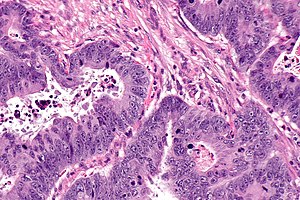Difference between revisions of "Nuclear atypia"
Jump to navigation
Jump to search
| Line 1: | Line 1: | ||
[[Image:Colorectal adenocarcinoma - alt -- high mag.jpg|thumb|right|300px| | [[Image:Colorectal adenocarcinoma - alt -- high mag.jpg|thumb|right|300px|Nuclear atypia and [[stromal desmoplasia]] in [[colorectal adenocarcinoma]]. [[H&E stain]].]] | ||
'''Nuclear atypia''' is abnormal change of the cell nucleus. Nuclear atypia is often seen in [[malignancy]]; however, it may be seen in benign conditions - notably inflammation. | '''Nuclear atypia''', also '''atypical nuclei''', is an abnormal change of the cell nucleus. | ||
Nuclear atypia is often seen in [[malignancy]]; however, it may be seen in benign conditions - notably inflammation. | |||
==Cancer with minimal nuclear atypia== | ==Cancer with minimal nuclear atypia== | ||
Revision as of 08:28, 13 September 2014
Nuclear atypia, also atypical nuclei, is an abnormal change of the cell nucleus.
Nuclear atypia is often seen in malignancy; however, it may be seen in benign conditions - notably inflammation.
Cancer with minimal nuclear atypia
An incomplete list:
- Low grade papillary urothelial carcinoma.
- Some adenocarcinomas of the upper gastrointestinal tract, e.g. gallbladder adenocarcinoma, stomach adenocarcinoma, ductal adenocarcinoma of the pancreas.
- Invasive lobular carcinoma.
- Verrucous squamous cell carcinoma.
- Some malignant melanomas.
